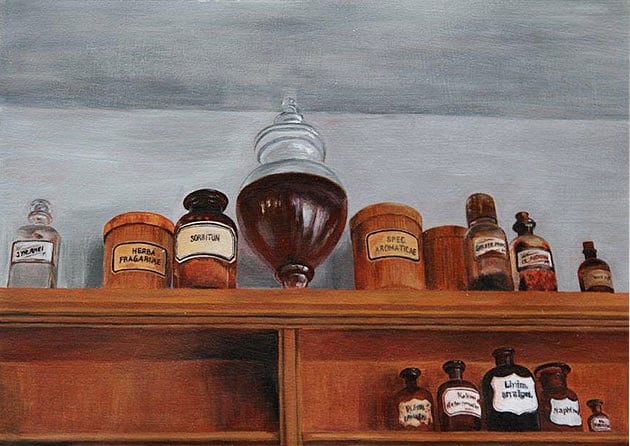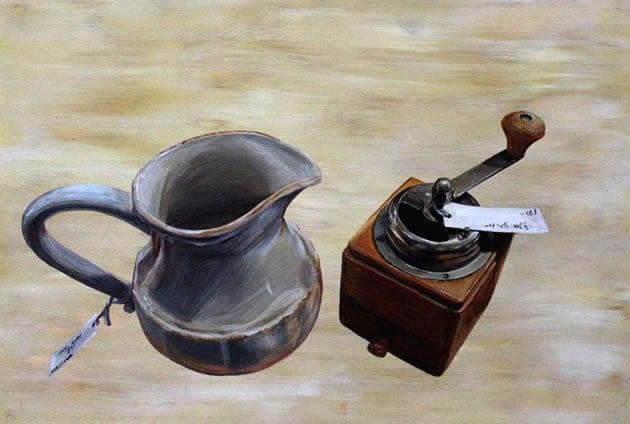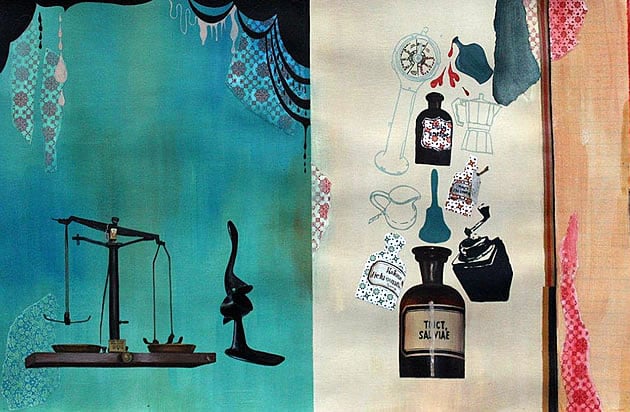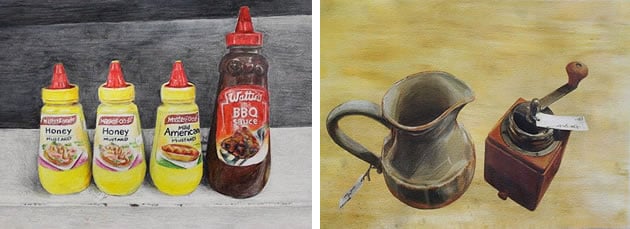A contemporary approach to still life: A Level Art
Concluding Updated on January v, 2022
This exemplary Painting and Related Media projection was completed by Jiwon Im, while studying A Level Art and Pattern (Cambridge/CIE) at Macleans College, Auckland, New Zealand. Jiwon was awarded Height in the World for her 99% AS Art and Design submission and 96% for A Level overall (2012). She likewise gained NCEA Level 3 Painting Scholarship for a separate projection completed using the aforementioned theme.
Two of Jiwon's sketchbook pages are included in our new book: Outstanding High Schoolhouse Sketchbooks . This book has loftier-resolution images and so that fine details and annotation are clear, making it an excellent resource for students and schools. Learn more!
Jiwon's project is an excellent instance of how personal ideas can exist adult and extended with the use of advisable creative person models. Using acrylic and other creative mixed mediums, such every bit collaged patterned paper (created in Photoshop), lined paper covered with acrylic or watercolour wash, masking tape cut-outs that are pasted on, and gel medium to create texture, Jiwon works with the sophistication and confidence of a mature creative person.


Nosotros were lucky enough to interview Jiwon about her A Level Art project. Her responses are below.
Your project begins with drawings of an intriguing interior infinite and even so life items bundled on shelves. Please talk to us about the ideas backside your work and why you chose this subject matter.

Jiwon: I started past going to The Apothecary (an antique cafe in Howick, Auckland) and taking my own photos. I chose this subject matter because I was more confident cartoon and painting still life objects and I found them more than interesting than landscape or portraiture. I also dealt with still life objects in As level so it helped me to develop some of the ideas I discovered in Every bit level and explore them in more depth. I studied both Painting and Graphic Design in high schoolhouse and so I was very interested in exploring the boundaries between design and painting. Do these fields even exist as entities? Information technology is this interconnection of approaches that informs my own work.
I looked at many other ideas throughout the twelvemonth. These include: guild, categorising (shelves and objects aligned in rows); containment (within spaces – jars, cans, bottles); labelling (bottle label text, postage stamp blueprint); and history/past (antique objects) as a decoration in present earth. Some other major theme within my work was old vs. new. I incorporated one-time objects into my work that were influenced past modern blueprint. This idea developed towards the finish of my preparatory piece of work, where I started to combine parts of objects together to make new objects.
I started the projection past exploring the interior space of the cafe, and so focusing on detail objects that were interesting. As I progressed through the boards, I ended upwards with a set of objects from the whole space. This was the result of my development of ideas and also ideas from artist models.



Aside from your superb technical skill, your piece of work stands out for the intelligent manner that y'all take used artist models to inform and influence the cosmos of original compositions. This is something which many students struggle with. Please talk to us about the artists you studied and how these influenced and shaped your work.
Jiwon: I was encouraged past my teacher to await for creative person models and refer to their ideas or techniques to develop my ain work. This really helped me. Most ideas came after artist model inquiry using books, with some from the internet. The first artist models that I used were David Salle and Seraphine Pick. Their work helped me to break away from merely painting things as they appear and encouraged me to showtime rearranging spaces and brand them my own. Their work showed me ideas like preparing a background first and painting objects over information technology so that objects bladder in space. David Salle divides his work in sections and uses inserts as well every bit various other techniques like outlining, employ of patterns and text.
Other artists I studied included Lars Henkel (repetition, irresolute parts of objects – eastward.1000. scale, some outline, some silhouette, some monochrome, some full colour), Susanne Kerr (utilise of patterns) and Emmanuel Polanco. Emmanuel Polanco's piece of work is design-based and his influence is visible from the commencement of the second A1 sheet of preparatory work. This graphic design approach, combined with my antique discipline matter, shows the coexistence of old and new; and painting and design. The works show various ways of sectioning, silhouettes and using mixed media.
From the end of the second prep sheet, I introduced new ideas influenced past the artist Camille Rose Garcia. I learnt to apply layers of colour to create depth in my background. The dripping shapes came from the same creative person. This helped me to explore the idea of Alchemy and Art (the bottles reminded me of magic and chemicals).
Banksy'due south blackness and white painting technique was used to reinforce the idea of coexistence old and new; painting and blueprint. The dripping idea was developed in the 4th preparatory sheet using the influence of the creative person Fuco Ueda who uses 'stained' texture. I used watercolour for this technique.
Artist models were crucial for the development of my piece of work throughout the yr.












What did you detect near challenging about the A Level Art course?
Jiwon: I had difficulty in exploring different perspectives and views of the objects considering the photos I took at the start were limited (I was not able to move objects from the shelves and rearrange them) and this made my piece of work seem repetitive. But my teacher went to The Apothecary antique cafe and they kindly allowed u.s. to borrow some of the called objects (bottles, calibration, stamps) so I had additional photos of these objects in interesting perspectives. This really helped in developing my work, especially in the fourth canvas of preparatory piece of work.
Having to think about both CIE A level and Scholarship (encounter below) was also challenging sometimes because the due dates weren't far apart. But the up-to-date periodical work and documenting of creative person models throughout the year really helped to get the 8 Scholarship pages done.



For those who are not aware, NCEA Scholarship is a separate examination taken by the very top candidates in New Zealand. Information technology has different requirements and deadlines than CIE A Level Art and Design and entering both qualifications has several challenges, specially for Painting students. Talk to me about the challenges yous faced when submitting work for both qualifications and how y'all overcame these.
Jiwon: I call back Scholarship is something virtually students in New Zealand aim for in their last year of high school. I was worried nearly the outcome because I knew the NCEA working process is different from CIE, but my teacher helped us from the start of the year to programme ahead so that nosotros could terminate both CIE and Scholarship piece of work. We used our As work for Scholarship entry and at first this worried me, considering I would be competing with NCEA Level 3 students. Students who did Scholarship at our school were encouraged to choose a like subject area matter or ideas as their AS work so that we could easily supersede or add some paintings equally colour copies. Many students (including me) chose to use their Every bit Controlled Test for Scholarship, just as we only produce 2 preparatory boards and one A2 final painting, we needed to add more work to make 3 total boards required for NCEA. For the 8 pages of journal work that are needed for Scholarship, I had to browse pages from my CIE periodical and rearrange them into the 8 pages. They included: brainstorm of ideas and final proposal, artist models and experimentation, limerick plans (layout of paintings) and accompanying notes. I included many of my CIE A level paintings in the sketchbook that I was not able to include in the iii Scholarship boards. The teachers really helped us a lot throughout the year. It wouldn't have been possible without them!



What communication practice you lot have for other high school Art students who wish to gain splendid grades?
Jiwon: Always starting time with research and refer to the artist models if you struggle with developing ideas. Near of the time books have much more information and multifariousness of artists than the internet. Just flip through them and annotation downwardly whatever artists yous like and refer back to them. I would also advise other art students to keep their journals up-to-date with their new ideas or artist models they find, also equally plans and trials/experimentation. Lastly, don't hesitate to ask your teacher for advice and help!
This is the 2nd superb high school Fine art projection we have featured from the Fine art Department of Macleans College. If you would like to view more outstanding student artwork, please view our Featured Art Projects!
The Pupil Art Guide is defended to helping high school Art students excel. If you know others who would benefit from reading this article, delight share information technology using the social media buttons below!

Amiria has been an Art & Design teacher and a Curriculum Co-ordinator for seven years, responsible for the course blueprint and assessment of student work in two high-achieving Auckland schools. She has a Bachelor of Architectural Studies, Bachelor of Architecture (Starting time Grade Honours) and a Graduate Diploma of Teaching. Amiria is a CIE Accredited Art & Design Coursework Assessor.
Source: https://www.studentartguide.com/featured/contemporary-still-life-a-level
0 Response to "A contemporary approach to still life: A Level Art"
Post a Comment